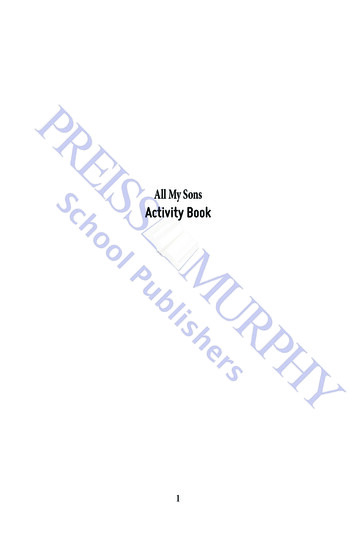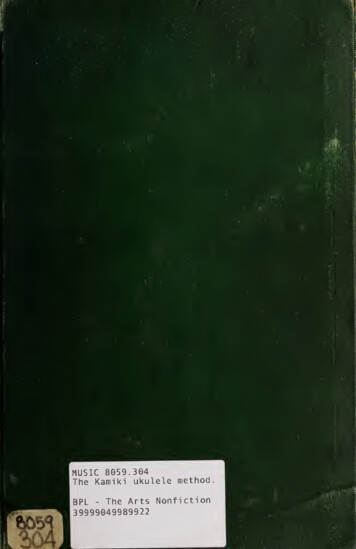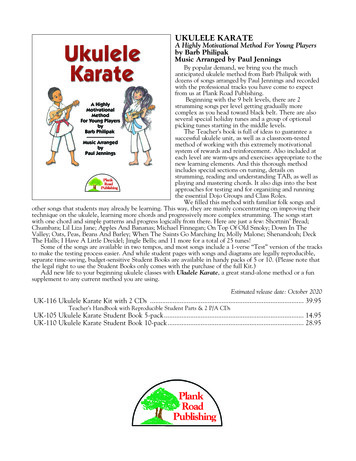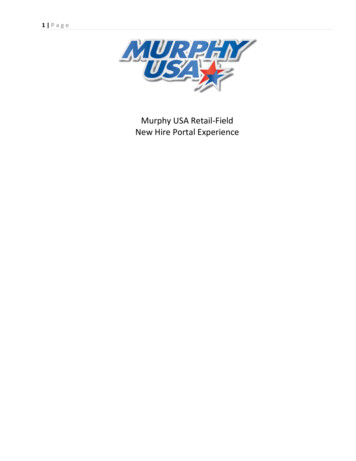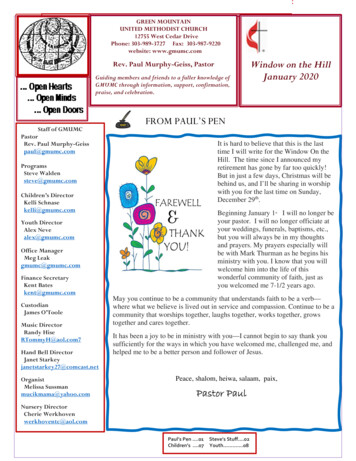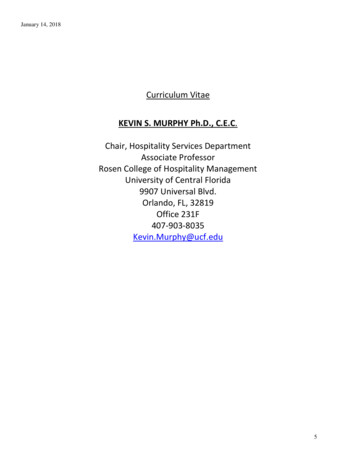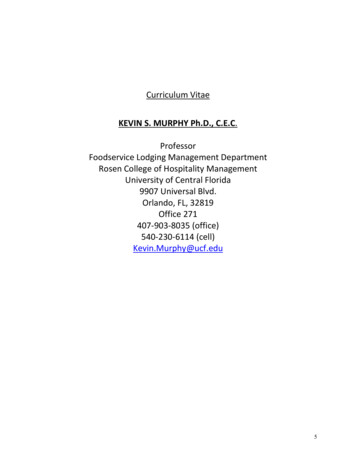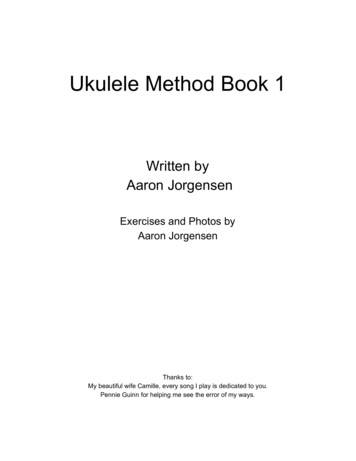
Transcription
Ukulele Method Book 1Written byAaron JorgensenExercises and Photos byAaron JorgensenThanks to:My beautiful wife Camille, every song I play is dedicated to you.Pennie Guinn for helping me see the error of my ways.
Ukulele Method Book 1By Aaron JorgensenThis MethodThis method book is meant to be used as a complement to private lessons, butcan offer a great number of insights into the ukulele for anyone looking to learn bythemselves. This method won’t promise unrealistic results in an astoundingly small spanof time, or offer an in depth analysis of music theory, and how it pertains to the ukulelefretboard.This book is meant to provide everyday people with the chords, notes, strummingpatterns, essential techniques, and a working knowledge of basic music theory that willallow them to strum through songs, play at family parties, bring their ukulele with themwherever they go, and maybe even accompany them at a gig.Chapter 1 - Getting StartedPracticeAs I said before, this is not the method for someone looking for the quick fix withminimal practice. Music is an art form that requires patience and regular practice.As you make your way through this ukulele method I suggest devoting 10-15 minutesevery day to practicing the ukulele, and dedicating a full week to each Chapter orsection. Every one of my students at some point or another has heard, or will hear mesay, “That was 95% Perfect, let’s go for 100% this time.” Take the entire week (or moreif needed) to get each lesson up to “100%.” You only live once, why not do everything100%?Self-AssessmentAlong with developing the discipline to adhere to a regular practice schedule,you’ll want to regularly police yourself as your own greatest source for constructivecriticism. As you move through this method regularly ask yourself questions like, “didthat sound right?” Am I playing that the way it should sound?” and most importantly,“Was that my 100% ?”
Parts of the UkuleleBody- the large, often hollowpart of the ukulele where thebridge attaches.Bridge- the wood part thatholds the strings in place, andattaches to the body.Saddle- the often white partthat is inlayed into the bridge,where most of the tensionfrom the strings is stored.Often made from bone,plastic, or synthetic bone.Top- the part of the bodywhere the bridge attachesusually with the sound holecut in it.Sound Hole- this is where the vibrating air inside the ukulele is able to escape, andwhere the sound resonates from.Heel- where the neck connects to the body on the backside of the instrument.Rosette- circular decoration around the sound hole.Binding- a decorative border on the edges of an instrument.Headstock- the area opposite the body at the end of the neck where the tuners are.Headcap- Front of the headstock often featuring a decorative laminate.Tuners/Tuning Machines- machines that attach the strings to the headstock andcontrol the tension and pitch.Tuning Button- The button at the end of the tuning machine that allows you to turn thegears.Nut- piece of bone, synthetic bone, or plastic, slotted to allow the strings to passthrough. Point that holds the string tension on the neck.Neck- the rounded wood piece that connects the body and the headstock.Fingerboard/ Fretboard- the playing surface on the front of the neck, the fret wires arethe wires inlayed into the wood, the frets are the spaces between the wires.
ToolsThere are a few tools that should be used as a compliment to this book. A feware recommended, but some are essential to helping you develop into a solid ukuleleplayer, and musician. Metronome Metronomes come in many shapes and sizes from the older trapezoidshaped units with the swinging pendulum to the newer electronicmetronomes, to the even more recent innovation of smartphone apps. Ipersonally prefer the smartphone apps, but try a few apps and see whatyou like. If you prefer to have a separate “tool” that lives in your ukulelecase, that’s great as long as you use it! Tuner Recordings of the tuning notes for a ukulele can be found online, It’s greatto dedicate the time to learn to tune by ear, but with the technologicaladvances available today, it’s not always necessary to go through thefrustration of trying to tune by ear as a beginner. Go to your local musicstore and ask for a “clip-on tuner,” (I prefer the clip on style) or search yoursmartphone’s app store for a free ukulele tuning app. By the time you readthis, this section may be out of date, tuners change all the time. Just visityour local music store to see what’s new. Practice Sheet (see Appendix A) Your practice sheet allows you to track your daily practice, lay out yourlesson plan & goals and set out a clear path as you make your waythrough this book. On this sheet you can track the days you practiced andhow long you practiced for, as well as which exercises you’re going towork on. You can record the song you’re working on, there’s even roomfor an instructor to assign listening examples. Use the practice sheet, itwill help! 3 Ring Binder (optional) I highly recommend getting a 3 ring binder. Nothing fancy, just thatstandard kind with the plastic outside just as long as it has a pocket on thefront and back cover, and has the standard 3 rings on the inside. I alwayskeep my current practice sheet in the front pocket. Additional resources,and old practice sheets in the back cover pocket and all of the songs I’velearned over the years on the 3 rings (in alphabetical order). This way youcan go back and review songs easily and you don’t have to rely entirely onmemory.
RampingOne thing that sets my method apart from many others is my use of graduallyincreasing the speed of an exercise in a process I call “ramping.” Below most exercisesin this book you’ll find a series of numbered boxes.As you go through each exercise you’ll gradually increase your metronome tomatch the number in the box or beats per minute (BPM) a nd cross off the number in thebox as you complete the exercise at that speed. When you reach the Goal Speedwhich in this case would be 100bpm you’ve completed the exercise!Choosing Your GearA lot of method books will dedicate an entire page to choosing your ukulele. Just knowthat there are 4 basic sizes of ukulele,-Soprano (smallest & most common),-Concert ( a little bit larger)-Tenor, (larger still)-and Baritone (largest of these 4 sizes)This book will focus on the Soprano, Concert, and Tenor ukuleles, as these are themost common, and all 3 are tuned the same (G,C,E,A). The baritone ukulele is tuned toD,G,B,E, so exercises in this book will not apply to a baritone ukulele.I can sit here and spill all of my knowledge of ukuleles into these pages, or youcould exhaust yourself with extensive internet searches on the subject. Myrecommendation on the subject, however, is go to your local shop, and find the ukulelethat speaks to you. It’s not necessary to buy the top of the line uke right off the bat. As amatter of fact, when I’m learning something new I like to reward myself with somethingnice upon the completion of a personal goal (i.e. completion of this book). You alsodon’t want to buy something cheap that will hinder your ability to play.**Find something that is good enough quality to assist your learning process, andnot hinder it, but save the high end model as a reward for reaching your goals **
Tuning the UkeBefore we get to tuning let’s “name” the stringsTake a look at the strings, the one furthest away from you (closest to the ground whenholding the ukulele in playing position) will be #1, the next one up is #2, then #3, and theone that’s closest to you, or farthest away from the ground will be #4.Your tuning notes are:#4 - G #3 - C #2 - E#1 - AUse your tuner to get each string tuned up or down until you find the correct pitch. If youhave any trouble tuning your ukulele ask your teacher, or an employee at your localmusic store for help.Tips for Tuning As you get close to the correct pitch make sure you make very smallturns. Most students try to tune right up to pitch as quickly as possibleand end up over and undershooting it. Just be patient and you’ll getthere faster. Always tune up to the correct pitch. Tune a bit flat, and then go up toyour desired pitch, they equalize tension better that way. Ukuleles fall out of tune all the time! It’s one thing you’ll have toaccept as a ukulele player. Be sure to practice tuning often, and getin the habit of tuning every time you pick up your uke. Come up with a phrase to help you remember your tuning notes. Mypersonal favorites are G ood C ows E at A nts, or G orillas Ca n E atA nything
Reading Chord DiagramsStringsThe vertical lines r epresentthe strings of your ukulele.The line that is farthest rightrepresents the 1st string (A),and it moves left to thefarthest left line representingyour 4th string (G)FretsFrets are the spaces inbetween the Fret wires o nyour ukulele. This diagramrepresents frets 1-4 with the space between each line being a fret .FingersJust like the strings and frets each finger is represented by a number . The index finger is your 1st The middle finger is your 2nd The ring finger is your 3rd The pinkie finger is your 4thPutting it all togetherAs you slowly learn to read a chord diagram, don’t try to jump into it head first. Takeeach new chord 1 finger at a time until you feel comfortable enough with reading them.In the diagram above, start with the 1st finger and work your way to the third.1. 1st finger, 3rd string, 2nd fret2. 2nd finger, 1st string, 2nd fret3. 3rd finger, 2nd string, 3rd fret4. Strum the chord and make sure it sounds good!
Troubleshooting chordsNow is a great time to go over some finer points of making chords. Here are a few“rules” to adhere to when putting together your new chords.Rule #1- Close, But Not TouchingYour finger should be just behind the forward fret wire of the fret you’re holding (forwardfret meaning the fret wire that is closest to the body of the ukulele). The trick is to makesure you are not on top of the fret wire itself, or you’ll get a soft buzzing sound, or thewrong note all together.CorrectIncorrectIncorrectRule #2- Tip Of Your FingersWhen you hold a chord down you should be contacting the string with the very tip ofyour finger (not the area opposite the fingernail, but the very “peak” of the finger).If you’re up on the tip of your fingers ,your fingers won’t accidentally touch stringsthey’re not supposed to.CorrectIncorrectRule#3- Thumb on back of neckThe thumb should be firmly placed on the back of the neck behind the center of thechord. If the chord isn’t working, try something different with your thumb.CorrectIncorrectIncorrect
RhythmOne of the major parts of playing music is time. Pieces of music are divided into bitesized portions called “measures” or “bars.” You can assign a number of “counts” to ameasure depending on the song or exercise.For right now we’ll look at measures consisting of 4 counts or 4/4 time.There are different types of notes that sustain for different durations of time. The 3 thatwe’ll look at in this exercise are whole notes, half notes, and quarter notes.Whole notes- A whole note will sustain for 4 counts, or the whole measure. Whenstrumming or playing a whole note, play the note on the 1 and leave it ringing for counts2, 3, and 4.Half notes- a half note sustains for 2 counts or half the measure. W hen strumming orplaying a half note, play the note and let it ring for one additional count (i.e. strum on 1let it ring through the two, strum 3 let it ring through the 4).Quarter notes- a quarter note gets 1 count, so you’re able to fit 4 quarter notes into ameasure in 4/4 time. If there are 4 quarter notes in a measure you’ll strum or pluck anote on each count. 1, 2, 3, 4.Strumming rhythmsStrumming rhythms work very much the same way, but the notes look like “blockier”versions of their usual selves. When you see one of these you’ll strum all 4 strings.
Chapter 2 - Strumming Basic ChordsLet’s start with 3 basic chords and strum a few measures of music.Below we have the chords C, Am (A minor), and FStart by making and strumming each chord to be sure everything sounds okay. When you’ve got each chord figured out, let’s put them into a few exercises.Tips:-The symbol at the end of each exercise (two lines with the 2nd one bolded)signals the end of the song or exercise. That’s how you know when to endan exercise, or end a song.-Remember that the blockier looking notes we looked at in the last sectionmean that you strum the chords rather than just plucking a single string . In theexercises below strum downward with your thumb for each note . We’ll switch up ourstrumming a little in some later exercises.-Remember to ramp up the tempo as you go. In this exercise you’ll start with yourmetronome set to 60bpm. When you complete the exercise at 60bpm without anymistakes, cross off the box that says 60 and move your metronome up to 70. Repeatuntil you complete the exercise at 80 bpm.
#1Goal- 80bpm#2Goal- 80bpm #3Goal-80bpm
Ukulele Method Book 1 By Aaron Jorgensen This Method This method book is meant to be used as a complement to private lessons, but can offer a great number of insights into the ukulele for anyone looking to learn by themselves. This method won’t promise unrealistic results in an astoundingly small span of time, or offer an in depth analysis of music theory, and how it pertains to the ukulele .

